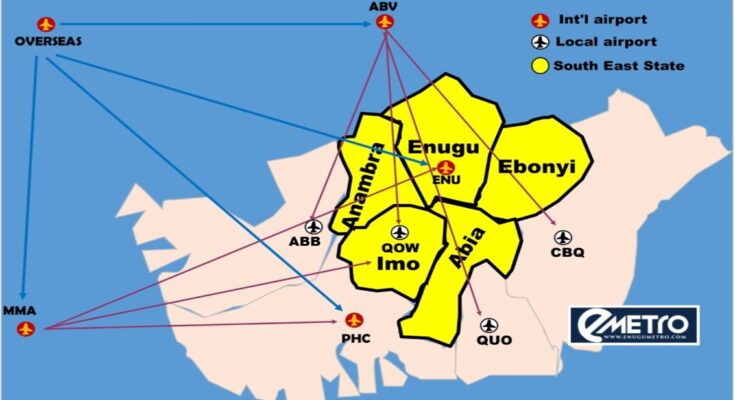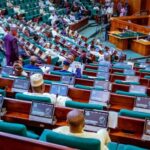By Chukwuma Okoli & Ndu Nwokolo
In the last few days, Nigeria’s military, through its Joint Task Force South East Operation UDO KA II, launched several airstrikes and ground clearance operations in various locations suspected to be camps of some non-state armed groups (NSAGs) operating across Nigeria’s Southeast region. Among the areas bombarded by the military are Orsumoughu in the Nnewi South Local Government Area (LGA) of Anambra State and Aku Ihube in the Okigwe LGA of Imo State. These locations are part of the areas described by Nextier as ‘Southeast’s belt of violence’ based on insight drawn from an analysis of violence patterns in Nigeria’s Southeast region. The ‘Southeast’s belt of violence’ is a vast area consisting of about 20 interconnected LGAs spread across the five states of the Southeast. These areas are located on the boundaries of the states, but together, they form an unbroken forest line that runs through the five Southeast states.
From Oguta LGA in Imo and Ogbaru LGA in Anambra, it connects Ihiala, Okigwe, Orlu, Umunneochi, Ideato, Orsu LGAs in Imo State with areas Ihiala, Nnewi South, Aguata, Orumba South LGAs in Anambra State. It runs through Oji River, Awgu, and Aniri LGAs in Enugu State, connecting Ebonyi State through Ivo and Afikpo LGAs and then proceeds through Isiukwuato and Bende in Abia State. Together, these areas constitute ungoverned spaces in the Southeast which have been appropriated by a network of criminal elements, including spiritual leaders/herbalists who provide spiritual support to the criminal network. Much of the past three years of violent criminal activities in the Southeast have occurred in this Southeast’s belt of violence. Despite various interventions by state actors, the Southeast’s belt of violence remains an ungoverned space which serves as an operational base for violent NSAGs. This edition of Nextier Policy Weekly reflects on enablers of radicalisation in Southeast’s belt of violence and how state actors can better deradicalise the space to enhance security in the Southeast.
Radicalisation in the Southeast’s Belt of Violence
The areas that make up the ‘Southeast’s belt of violence’ are the most radicalised locations in the Southeast. This radicalisation explains why the ‘Southeast’s belt of violence’ has turned out to be the epicentre of violence and criminal activities in the Southeast. The area has become infamous for criminal activities such as kidnapping for ransom, attacks on state security agencies and destruction of government installations. Data from the Nextier SPD violent database shows that between January 2021 and September 2023, the area recorded at least 33 kidnap incidents and 220 deaths arising from violent confrontations (See Figures 2 & 3).
The radicalisation of the Southeast’s belt of violence is enabled by two major factors. First is the exploitation of the geographical terrain of the area by NSAGs. The areas that make up the ‘Southeast’s belt of violence’ are mainly interconnected border communities with thick forests, extensive hills and mountains. These geographical characteristics make it easy for criminal elements to move small arms and light weapons across different state borders and build camps in hard-to-reach areas where even aerial bombardment by state security agencies would have little or no impact. Many NSAGs have taken advantage of the difficult geographical terrain of the ‘Southeast’s belt of violence’ to make these locations the major operational areas. More so, due to the remote nature of most communities within the ‘Southeast’s belt of violence’, there is usually a low presence of state security forces in the areas. The NSAGs take advantage of the near absence of state security agencies in the locations to frighten the communities into silence with violence and threats. In some communities, residents are subjected to extortion and forceful conscription of the youth by some NSAGs operating in the areas.
Another factor contributing to the radicalisation in the ‘Southeasts belt of violence’ is the prioritisation of kinetic strategies by state security agencies. State security agencies seem to have focused more on using force to decimate the NSAGs in the ‘Southeasts belt of violence’. In 2021 alone, Amnesty International reported that state security forces killed at least 115 people within four months and over 500 were arrested in various raids by the security agencies. The difficult geographical terrain may have contributed to the recent use of air strikes by the Nigerian military to bombard locations suspected to be camps of the NSAGs, the ‘Southeasts belt of violence’. However, these kinetic strategies have been counterproductive and sometimes contribute to radicalising the ‘Southeast’s belt of violence’. For instance, the recent air strike conducted by the military in Okigwe has received criticism from some quarters for inadvertently bombarding innocent civilians in attempts to destroy camps of NSAGs.
There are also allegations that in states like Imo, some politicians are using the opportunity to intimidate and suppress voters in the strongholds of their political opponents under the guise of destroying camps of the Indigenous People of Biafra (IPOB) and its militant wing – Eastern Security Network (ESN) (Personal Communication). According to one respondent: “As the state (Imo State) is preparing for 2023 governorship election, some politicians give false information to security agencies who now bombard strongholds of opponents so that there will be no election there for security reasons” (Personal Communication). On its part, the IPOB has released a statement through its spokesman, Emma Powerful, in which it claimed that the locations recently bombed by the Nigerian military in the Southeast were places occupied by unarmed civilians and ESN as claimed by the military. Besides, there are claims of unprofessional conduct such as extortion and harassment by some military personnel deployed on some major highways in parts of the ‘Southeasts belt of violence’. Such unprofessional conduct feeds into the propaganda used by the NSAGs to radicalise some community members who are told that the military are in the communities to subdue them instead of protecting them (Personal Communication). The ungoverned spaces and military approaches in the Southeast’s belt of violence coalesce to enable radicalisation by various NSAGs in the Southeast’s belt of violence.
Deradicalising Southeast’s Belt of Violence: The Ignored Options
Deradicalisation is a form of intervention for dealing with violent radicalism. It involves various measures, including mentoring, ideological or theological engagement, help with employment and education, and social and psychological support. There has been no conscious implementation of any comprehensive deradicalisation programme in the Southeast’s belt of violence. Much effort has been focused on addressing the symptoms of radicalisation instead. Thus, the federal and state governments have invested so much energy to forcefully end the NSAGs’ activities. Deradicalisation measures such as help with employment and education, provision of social and psychological support seem to be ignored as possible options to be included in the welter of measures aimed at deradicalising the Southeast’s belt of violence. Upon assumption to office, some of the state governors were quick to declare an end to sit-at-home and deploy security agencies to contain the activities of the NSAGs.
However, such measures have not ended the NSAGs’ activities, including the criminalities perpetrated under the guise of separatist agitation. This is because the mere declaration of an end to sit-at-home and the use of force to suppress the activities of NSAGs do not address the enablers of radicalisation by the groups. At best, the use of force tends to push the NSAGs to engage in more covert operations and move deeper into more remote areas of the belt of violence from where they operate, thereby making the Southeast’s belt of violence more dangerous. This was the experience in Anambra, where Governor Soludo’s sit-at-home declaration ignited more violent attacks on innocent civilians by the NSAGs. Similarly, in Enugu, many residents have continued to observe the Monday sit-at-home despite Governor Peter Mbah’s declaration of end to sit-at-home. The observance of Monday’s sit-at-home is connected to the fear of the NSAGs, who still have the propensity to cause harm to defaulters of the sit-at-home orders.
Recommendations: Deradicalising Southeast’s Belt of Violence
- Initiate safe corridor programmes for low-risk members of the NSAGs: As part of long-term measures to address the radicalisation in the Southeast’s belt of violence, the federal and state governments should initiate safe corridor programmes for low-risk members of the NSAGs who the NSAGs may have forcefully conscripted. The safe corridor programmes should include skills acquisition and psychological and social supports for the low-risk members to enable them to reintegrate into society.
- Deepen collaboration with the civil society and private sector in deradicalisation in the Southeast’s belt of violence: part of the soft approaches to the deradicalisation of the Southeast’s belt of violence is to partner with the civil society and private sector. The private sector, particularly credible consulting firms, would provide their expertise in knowledge creation on radicalising the target locations and designing effective evidence-based deradicalisation programmes. The civil society organisations, including faith-based, would contribute to advocacy against radicalisation.
- Deepen government presence in the Southeast’s belt of violence: many communities across the Southeast’s belt of violence do not feel the impact of the government. They do not have access to good healthcare, education, or basic amenities like pipe-borne water, electricity, etc. There is a need for government to extend some of such amenities to such locations. This would reduce the impact of propaganda deployed by the NSAGs to win the sympathy of members of such communities.
- Collaboration with local vigilantes: State security agencies should deepen collaboration with local vigilantes who understand the difficult geographical terrain of the local communities in the Southeast’s belt of violence. This will ensure that innocent civilian populations are not targeted during military operations.
- Strategic partnerships with local leadership in the area: Southeast communities have multiple governance structures. Apart from the elected state officials, the traditional rulers, the President General of the town unions, the leaderships of women’s Unions, the Markets associations, and the youth wings play important roles in each autonomous community’s day-to-day governance and security. Any effort at achieving sustainable peace and dis-lodging the NSAGs’ activities must have these organisations’ inclusion and buy-in. Providing local intelligence and engaging in activities will lead to behavioural changes and shifting incentives from violence and distrust for the Nigerian state to peace and trust will come majorly from their participation and engagements.
Policy Recommendations
- The federal and state governments should initiate safe corridor programmes for low-risk members of the NSAGs.
- There is a need to deepen collaboration with the civil society and private sector in deradicalisation in the Southeast’s belt of violence.
- There is a need for the government to deepen its presence in the Southeast’s belt of violence through the provision of social amenities.
- State security agencies should deepen collaboration with local vigilantes.
- There is a need for strategic partnerships with local leadership for enhanced local intelligence.
Conclusion
The rate of violence in the area designated by Nextier as ‘Southeast’s belt of violence’ signposts the level of radicalisation in the area by members of the NSAGs. The current radicalisation in the ‘Southeast’s belt of violence’ is enabled by two factors. First is the area’s geographical features, which turned the entire area into ungoverned spaces exploited by criminal elements. Secondly, the focus on the military approach as the only strategy to decimate the NSAGs contributes to radicalisation in the ‘Southeast’s belt of violence’. There is a need for a comprehensive deradicalisation programme to stem the tide of radicalisation in the ‘Southeast’s belt of violence’.
(Dr. Chukwuma Okoli is an Associate Consultant at Nextier and a Lecturer at the Political Science Department at Nnamdi Azikiwe University, Awka, Nigeria; while Dr. Ndu Nwokolo is a Managing Partner at Nextier and an Honorary Fellow at the University of Birmingham, UK School of Government)



